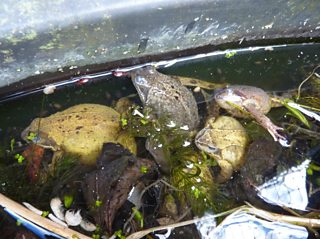Amphibians and winterkill – a worse than average year?
Dr Laurence Jarvis
Science and Research Manager
Earlier this year the UK was hit by the ‘Beast from the East’, which caused havoc with trains, roads and disrupted many businesses and jobs. However, it was not only people who were affected; many amphibians suffered as well. In particular, common frogs did not fare well in the cold conditions and the extreme weather caused the death of hundreds of frogs across the country. Known as winterkill, the death of frogs in garden ponds after the winter occurs to a degree every year. However, incidences of winterkill were far higher in the early spring of 2018.
What is winterkill?
Several species of UK amphibians overwinter in ponds, including common frogs and smooth newts. These animals tend to spend the winter in the silt and decaying leaves at the bottom of ponds. Normally this does not harm the animals and they resume breeding as usual the following spring. The advantage to spending the winter in the pond is that the frogs and newts are ready to breed as soon as the weather becomes warm enough. However, these amphibians rely on absorbing oxygen through their skin, especially during periods of cold weather. This can be a problem as sometimes during the winter months oxygen levels within ponds can fall and toxic chemicals build-up. This occurs more frequently when the surface of the pond freezes over for extended periods. Unfortunately this can result in the death of some amphibians and is commonly known as winterkill. This process is natural and every year a number of amphibians, mainly common frogs, die as a result of winterkill and this has no negative impact on populations.

Why was winterkill especially bad this year?
During January and early February 2018 we experienced relatively mild winter conditions across the UK, with only light overnight frosts. This encouraged the early emergence of common frogs and other amphibians, especially within the south of the England.
had sightings of great crested newts on 25th December 2017 and the first frogspawn was reported on 17th January 2018. The relatively mild conditions continued until late February, which triggered the movements of many common frogs towards breeding ponds. At the end of February, the UK experienced unusually cold and prolonged winter weather with hard frosts and snow.This sudden cold period of weather came quickly, when a large number of breeding frogs were already at ponds. Although these frogs may have tried to avoid the cold conditions, the combination of low temperatures, already low oxygen levels in ponds, along with an extended period of ice covering ponds caused the death of many frogs across the country. The Froglife enquiry service received a sudden and high level of reports of large numbers of mainly common frogs being found dead in ponds.
How many frogs died?
It is difficult to tell exactly how many frogs died but across the country it is likely to be several hundred and possibly thousands. Between 5th and 16th March Froglife received 26 enquiries relating to frozen frogs in ponds which resulted in the death of over 400 frogs. In several ponds frogs appeared to have frozen within the ice. The worst case was from a school pond where over 120 common frogs were removed dead from the water. This number of enquiries was higher than average as in most years Froglife only receives a handful of cases of winterkill across the whole winter and spring seasons.

What impact will this have on frogs?
It is too early to determine the impact of winterkill on common frogs and other amphibians.
Common frogs are relatively long-lived so any remaining frogs will be able to breed next year and this will help boost populations. However, the loss of a large number of breeding adults from areas may have an impact, especially where the number of frogs present is small and where they are already under stress from other factors such as loss of breeding and terrestrial habitats, habitat fragmentation, introduced disease and pollutants. Climate change may impact amphibians in several ways and an increase in extreme weather events may have long-term implications on amphibian populations across the country. We need more long-term studies to examine whether common frogs and other amphibians are negatively affected by repeated extreme weather events at key times during their breeding cycle.
